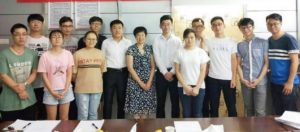We are very pleased to introduce Jin Liu and Zehua Lin, authors of the paper ‘Low-temperature all-solid-state lithium-ion batteries based on a di-cross-linked starch solid electrolyte‘. Their article has been very well received and handpicked by our reviewers and handling editors as one of our HOT articles. Jin Liu and Zehua Lin were kind enough to tell us more about the work that went into this article and what they hope to achieve in the future. You can find out more about the authors and their article below and find more HOT articles in our online collection.
Meet the Authors
 Jin Liu is a Professor in the School of Metallurgy and Environment, Central South University, China. She received her Ph.D. degree from the Department of Chemistry, University of Utah, USA, in 2006. Her research interests include electrochemistry and surface chemistry.
Jin Liu is a Professor in the School of Metallurgy and Environment, Central South University, China. She received her Ph.D. degree from the Department of Chemistry, University of Utah, USA, in 2006. Her research interests include electrochemistry and surface chemistry.
Zehua Lin is a Master student in the School of Metallurgy and Environment, Central South University, China, under the supervision of Professor Jin Liu and now studying in University of Utah, USA, as a visiting scholar. He received his bachelor’s degree in New Energy Materials and Devices in 2017 from Central South University. His research interests include investigation of new energy materials for all-solid-state lithium battery.
Jin Liu’s research group
Could you briefly explain the focus of your article to the non-specialist (in one or two sentences only) and why it is of current interest?
We are trying to investigate low-temperature applications of solid-state lithium batteries by designing new solid electrolytes. Although solid-state batteries have superior safety and energy density, their application is restricted by high operation temperature due to the inferior ionic conductivity and interfacial property of solid electrolytes. We believe only when solid-state batteries break through the limitation of high operation temperature can they satisfy the application in daily lives.
How big an impact could your results potentially have?
Our work reports the solid-state LFP battery achieves about 70% and 30% theoretical capacity at 0 oC and -20 oC separately, which is a significant progress on the study of solid-state batteries operating in such low temperature.
Could you explain the motivation behind this study?
Our team has been studying solid-state batteries since 2011. Solid-state batteries still do not satisfy performance criteria of liquid batteries working at low temperatures. We hope to make more improvement to that so we started this work.
In your opinion, what are the key design considerations for your study?
For the base materials, we use starch due to its hydroxy-rich and stable structure. By double cross-linking reactions with KH560 and BH3 to modify the –OH groups into –C-O-C–groups, we construct an orderly ether-bonded net for lithium salt dissolution and hybridize organic compounds with inorganic elements of B and Si at a molecular level to obtain this stable solid electrolyte.
In your article you mention that the findings provide a solution to solve the current challenges of ASSLIBs to widen their scope of applications. Do you have a particular application in mind?
Solid-state batteries circumvent leakage and flammability problems facing liquid batteries, enabling potential application in foldable electric devices. This would allow for powering of wearable electronics in clothing and other wireless devices.
Which part of the work towards this paper proved to be most challenging?
The experiments can be the most challenging part. Because the ingredients are sensitive to humidity but, unfortunately, the weather in Changsha city is mostly damp. So, we have to pay attention to prevent from moisture when keeping or transferring our materials.
What aspect of your work are you most excited about at the moment?
Our work demonstrates such a solid electrolyte battery can charge/discharge at 0 oC and even at -20 oC. The extremely low temperature ranges are exciting advancements for solid-state batteries.
What is the next step? What work is planned?
The solid-state battery has been developed for operation in low temperatures, but there is still a long way to actual application. Also, the mechanism of lithium-ion conducting in solid electrolytes is still unclear. We are going to continue our low temperature study to investigate the mechanism including the charge transfer in solid electrolyte and between the solid/solid interfaces of electrolyte and electrodes, and to improve the battery performance in the aspects of fast-charging/discharging and scale-up.
Low-temperature all-solid-state lithium-ion batteries based on a di-cross-linked starch solid electrolyte
Zehua Lin and Jin Liu
RSC Adv., 2019, 9, 34601-34606
DOI: 10.1039/C9RA07781B, Paper

Submit to RSC Advances today! Check out our author guidelines for information on our article types or find out more about the advantages of publishing in a Royal Society of Chemistry journal.
Keep up to date with our latest HOT atricles, Reviews, Collections & more by following us on Twitter. You can also keep informed by signing up to our E-Alerts.













